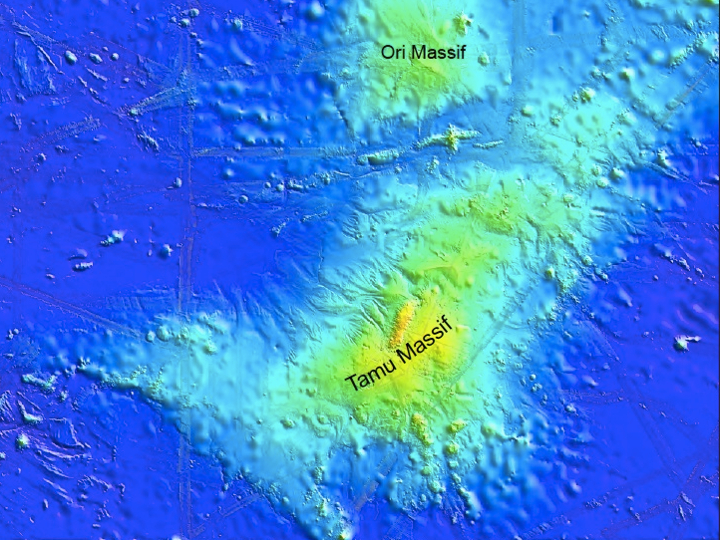New Findings Suggest a Re-Thinking of Massive Underwater Volcano
The discovery of Tamu Massif, a gigantic volcano located about 1,000 miles east of Japan, made big news in 2013 when researchers reported it was the largest single volcano documented on earth, roughly the size of New Mexico.

New findings, reported this week in Nature Geoscience, conclude that it is a different breed of volcanic mountain than earlier thought, throwing into doubt the prior claim that it is the world’s largest single volcano.
The study analyzed magnetic field data over Tamu Massif, finding that magnetic anomalies – perturbations to the field caused by magnetic rocks in the Earth’s crust – resemble those formed at mid-ocean ridge plate boundaries.
William Sager, a geophysicist at the University of Houston and senior author for the paper, said the discovery led researchers to conclude that Tamu Massif formed by mid-ocean ridge “spreading,” the geologists’ term for creation of ocean crust at mid-ocean ridge plate boundaries, rather than as a shield volcano, as previously thought. Shield volcanos are formed primarily as stacks of fluid lava flows and are one of the most common types of volcano.
An international group of researchers – from Texas, China and Japan – sought to understand how the massive Tamu Massif volcano formed near the nexus of three spreading ridges. The key, they report, is magnetic anomalies.
Mid-ocean ridges – plate boundaries where oceanic plates move apart – are themselves large volcanoes. These ridges record distinctive linear magnetic anomalies, parallel to the ridge, as they form new crust. This is a result of lava flows and magma being concentrated near the ridge axis where the magnetic minerals in the new crust record reversals of the magnetic field polarity.
A New Understanding of Tamu Massif
Linear magnetic anomalies formed by the three ridges had previously been found around Tamu Massif, but it was unclear where they stopped within the volcano. A paper published in 2013 by Sager and colleagues concluded that Tamu Massif is an enormous shield volcano, formed by far-reaching lava flows emanating from its summit.
The latest study compiled a magnetic anomaly map over Tamu Massif, using 4.6 million magnetic field readings collected over 54 years along 72,000 kilometers of ship tracks. The data set was anchored by a new grid of magnetic profiles, positioned with modern GPS navigation, collected by the study authors using the Schmidt Ocean Institute ship Falkor. The resulting map shows that linear magnetic anomalies around Tamu Massif blend into linear anomalies over the mountain itself – implying that the underwater volcano formed by extraordinary mid-ocean ridge crustal formation.
Sager said the finding is important because it demonstrates that Tamu Massif and other oceanic plateaus are formed by a different process than previously thought. A widely-accepted model suggests a large blob of magma, known as a “mantle plume,” rises through the mantle and creates a massive volcano when it arrives at the surface. This eruption is thought to be analogous to massive eruptions on land, called “continental flood basalts” and it creates a vertical succession of lava flows.
The ocean-ridge-spreading hypothesis suggests the age progression is instead lateral. New material is always added at the center of the ridge as older material drifts laterally away. An implication is that the gradual slopes of Tamu Massif are not caused by lava flow shape but instead by a gradual inflation and then deflation of ridge volcanism as the crust became thicker and then grew thinner.
The new finding also weakens the accepted analogy between eruptions of continental flood basalts and oceanic plateaus because the formation mechanisms are shown to be different, Sager said.
‘Certainly One of the Largest’
With the discovery, Sager said Tamu Massif can no longer be considered the world’s largest shield volcano. That title reverts to Mauna Loa, on the island of Hawaii.
“The largest volcano in the world is really the mid-ocean ridge system, which stretches about 65,000 kilometers around the world, like stitches on a baseball,” Sager said. “This is really a large volcanic system, not a single volcano.”
Researchers now think Tamu Massif formed as part of that mid-ocean ridge system, he said. “Tamu Massif is certainly one of the largest volcanic mountains in the world.”
The 2013 paper was based on what researchers knew at the time, Sager said. “Science is a process and is always changing. There were aspects of that explanation that bugged me, so I proposed a new cruise and went back to collect the new magnetic data set that led to this new result.
“In science, we always have to question what we think we know and to check and double check our assumptions. In the end, it is about getting as close to the truth as possible - no matter where that leads.”
In addition to Sager, corresponding author and professor of geophysics in the UH College of Natural Sciences and Mathematics, other authors on the paper include: co-corresponding author Yanming Huang, Yangtze University; Masako Tominaga and John A. Greene, both of Texas A&M University; co-corresponding author Jinchang Zhang of the Chinese Academy of Sciences; and Masao Nakanishi of Chiba University.
- Jeannie Kever, University Media Relations